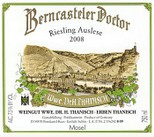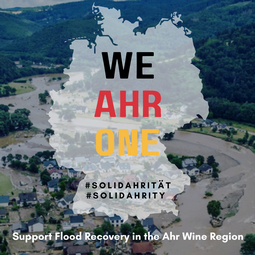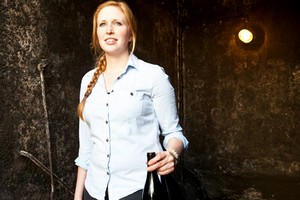This website is devoted to a selection of fine wine estates from Germany, which are available in the United States through various wine importers. This portfolio has been created by Eric Litchfield, an acclaimed authority on German and Austrian wines, who has spent considerable time selecting producers that define today's highest standards of winemaking. Mr. Litchfield's philosophy is allowing the wine producer and nature to harmonize equally, utilizing sustainable agriculture, organic and biodynamic farming to reach the purest expression of grape varietal, microclimate and terroir, yielding wines of supreme balance and elegance.
It is the objective of this website to provide comprehensive data about these fine wine estates as well as other aspects of the German wine industry, including: current news, understanding German wine labels, wine region information and vintage reports. It is our goal to make GermanWineEstates, The Site for German Wine Lovers.
Featured Wine Estate
The wine growing tradition of the Thanisch family dates back to 1636. The wine estate was founded in 1895 by Dr. Hugo Thanisch, a Prussian politician and his widow Katharina,  and gained its reputation through the spectacular success of the wine auctions of the VDP. Today the estate is managed by Sofia Thanisch, the great granddaughter of the founders, and the fourth generation of women.
and gained its reputation through the spectacular success of the wine auctions of the VDP. Today the estate is managed by Sofia Thanisch, the great granddaughter of the founders, and the fourth generation of women.
 and gained its reputation through the spectacular success of the wine auctions of the VDP. Today the estate is managed by Sofia Thanisch, the great granddaughter of the founders, and the fourth generation of women.
and gained its reputation through the spectacular success of the wine auctions of the VDP. Today the estate is managed by Sofia Thanisch, the great granddaughter of the founders, and the fourth generation of women.Berncasteler Doctor
The Riesling wines from the great “Berncasteler Doctor” vineyard are some of the most famous white wines in the world. These superb wines are highly prized by connoisseurs for their magnificence and complexity, making them some of the most sought-after wines of the entire Mosel-Saar-Ruwer region. The name Thanisch is inseparably linked to the “Doctor”.
Other Vineyards
The size of our boutique estate, including two of the most famous vineyards in Germany, the Berncasteler Doctor and the Bernkasteler Badstube, is 7 ha (16 acres). All our vineyards are planted with 100 % Riesling vines, most of which are mature and on original non-grafted rootstocks. The Devon slate soil gives our wines their unique character: delicate fruit, elegance and lightness.
Tidbits of Information
International Riesling Day: A Global Celebration of Riesling's Timeless Versatility
Information Supplied by Wine International Association
-13 March 2024-
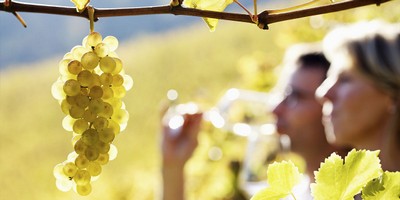
Riesling, with its unique ability to span the spectrum of sweetness levels and exhibit extraordinary aging potential, has left an indelible mark on the world of wine. It thrives in diverse terroirs, from the iconic Mosel in Germany, to the enchanting vineyards of Alsace in France, and the pristine Clare and Eden Valleys in Australia. Each region lends its own distinct charm to Riesling, making it a grape that transcends borders and captures the hearts and palates of wine lovers everywhere.
1. International Riesling Day: A Toast to the Timeless Allure of Riesling
On March 13th, wine aficionados around the world come together in a global celebration, clinking glasses to honor one of the most versatile and delightful grape varieties—Riesling. International Riesling Day is a cherished occasion, a moment when wine enthusiasts pay tribute to the bright, aromatic character of this exceptional grape. Riesling, celebrated for its diverse sweetness levels and extraordinary aging potential, has flourished in various regions. From the legendary Mosel in Germany to the enchanting vineyards of Alsace in France and the pristine Clare and Eden Valleys in Australia, Riesling has captivated the hearts and palates of wine lovers across the globe.
2. A Storied Past and a Promising Future
Riesling’s lineage can be traced back to an ancient wild vine that thrived in the woodlands along the Rhone River. This precursor was a frost-resistant vine with tiny fruit, setting the stage for the evolution of Riesling. Over centuries, it embarked on an intricate journey, crossing with Traminer and later with Weiser Hoinish. These unions endowed the grape with energy, disease resistance, and high acidity, ultimately giving birth to the Riesling we adore today.
The eighteenth century marked a turning point in the history of Riesling. It transitioned from obscurity to large-scale cultivation, emerging as the preferred choice to replace less noble grape varieties. The wines produced from Riesling grapes graced the tables of monarchs and emperors, earning an esteemed place in the annals of wine history. Among these wines, German Rieslings stood out, achieving global recognition by clinching the prestigious “Grand Prix” at the St. Louis World’s Fair in 1904.
3. What to Pair with Riesling
One of the intriguing aspects of Riesling is its remarkable versatility when it comes to food pairings. While Riesling’s adaptability allows it to complement a wide range of dishes, the main consideration is that the food should be rich in spices or even possess a spicy kick. This makes Riesling an excellent choice for a variety of Far Eastern, Chinese, or Indian cuisines.
The bright acidity and balanced sweetness of dry Riesling harmonize beautifully with the intricate flavors of these dishes. For those with a sweet tooth, semi-sweet and sweet Riesling varieties are the perfect dessert wines. Pair them with sweet pastries or a delightful fruit plate for a match made in heaven. However, when it comes to aged Rieslings, connoisseurs often prefer to enjoy them on their own, while some avant-garde wine enthusiasts find that these gems pair exquisitely with a scoop of creamy ice cream, proving that the possibilities are as diverse as Riesling itself.
4. Expression of Terroir – Where to Taste the Best Riesling
Riesling’s unique capacity to reflect its terroir, or the environment in which it’s grown, allows it to express its diversity while preserving its intrinsic characteristics. With over 70% of Riesling cultivation in the northern hemisphere, between the 48th and 51st parallels, there are plenty of places to embark on a Riesling tasting adventure for International Riesling Day. Some of the world’s top Riesling-producing regions are waiting to welcome you into their cellars for an unforgettable Riesling experience. Take, for instance, the enchanting Mosel region, known for its floral Rieslings.
These wines are distinctly lighter and are easily identified by their pale hue and lower alcohol content. They are characterized by a signature floral bouquet, reminiscent of a garden in full spring bloom. Mosel Rieslings captivate with their charm and delicacy, and the best among them are marked by their mineral elegance and an unexpected aging potential. So, set out on a journey to explore the terroirs that shape these incredible Rieslings, where each sip tells a unique story of the land.
International Riesling Day is a testament to the enduring allure of Riesling, a grape that has captured the hearts of wine aficionados worldwide. On March 13th, wine lovers from all corners of the globe unite in a harmonious celebration, toasting to the versatility and delightful character of this exceptional varietal. Riesling’s remarkable range of sweetness levels and its extraordinary capacity for aging have propelled it to prominence in regions as diverse as the legendary Mosel in Germany, the enchanting vineyards of Alsace in France, and the pristine Clare and Eden Valleys in Australia.
The Terrible Flooding in Germany’s Ahr Wine Region and Help for its Wineries
Information Supplied by Wines of Germany
-8 August 2021-
The flooding in Germany last week has had a devastating impact on many in the German states of Rhineland-Pfalz and North Rhine-Westphalia, including and especially the wine producers of the Ahr Valley. Throughout Ahrweiler and the surrounding villages of Mayschoss and Dernau, the deluge of water has wrought devastation both human and economic.
The recent floods have caused the death of more than 180 people across Western Europe – including at least 112 in the Ahrweiler area alone. The economic devastation that accompanied the floods was particularly hard felt by the region’s more than 38 wineries, many of whom lost their facilities, cellars, machinery, wine barrels, cellared inventory and more, destroying entire wine-producing businesses and livelihoods. It will likely take weeks to quantify the number of wine-growing businesses affected as well as the severity and extent to which the disaster will affect the entire Ahr region and its 563 hectares of vineyards.
The Managing Director of the German Wine Institute (DWI) Monika Reule was stunned by the devastation and the fate of those living there who are now struggling for their livelihoods. “Our hearts break for those affected by the flooding in the Ahr, Mosel, and all throughout Germany. Following the weekend flooding, DWI offers our help to the wine industry in the Ahr region. While the devastation is difficult to bear witness to, it’s been inspiring and gratifying to see the entire German wine industry – and all of Germany – come together in solidarity to support those affected by the flooding.”
A number of growers from different wine regions are already on site with forklifts, vineyard tractors and pumps to support the clean-up and recovery effort and salvage what can still be saved. Other volunteers are also on the ground helping with any urgently needed vineyard work in order to prepare for the upcoming grape harvest. In addition to the on-site help, numerous monetary and in-kind donations have been made to benefit affected wine producers in the Ahr.
The DWI is currently gathering aid and donation offers while also generating its own donation in collaboration with its partners and agencies domestically and abroad. Here at the U.S. office of the German Wine Institute, we are collecting monetary donations to support the recovery efforts via a GoFundMe campaign. Contributions will be routed to the Ahr Winegrowing Association’s account at the Farmers and Winegrowers’ Association of Rhineland-Nassau so that proceeds from the numerous aid campaigns can directly benefit the Ahr winegrowers in urgent need of financial support.
Support Flood Recovery in the Ahr Wine Region by Donating Here: GoFundMe
Happy Birthday Riesling!
Information Supplied by Wines of Germany
-13 March 2021-
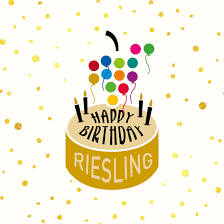
Germany's most important grape variety, Riesling, celebrates its 586th birthday on March 13th. On this day, the grape variety was first mentioned in a written document in 1435. Under the hashtag #rieslingbirthday, actions take place worldwide from Amsterdam (NL) to Toronto (CA).
All 14 ‘Wines of Germany’ information offices will again celebrate the Riesling birthday on 13 March - with events, but above all with social media activities in various languages. If you want to be part of it, you will find three suitable images at the end of the article which you can download for free.
Determining the global image of 'Wines of Germany'
Riesling grapes grow on almost a quarter of the vineyards in Germany. Like no other grape variety, Riesling determines the global image of the 13 German wine growing regions. Germany is considered to be the home of Riesling, because around 23,800 hectares are around 45 percent of all Rieslings in the world.
The early spread of Riesling with initial evidence for the 15th century, the growth, the size of the grape berries, the long maturation period and frost resistance show the relationship with wild grapes. Winegrowers in the Rheingau and on the Mosel have the longest Riesling tradition. There are historical documents from there dating back to the years 1435 or 1465.
Documented mention of Riesling in 1435 A.C.
There are numerous "first” mentions of the grape, yet the earliest documented mention of Riesling is an invoice dated 13 March 1435, from Klaus Kleinfisch to his lord, Count Johann IV of Katzenelnbogen, for the purchase of Riesling vines to be planted next to the fort he was building in Rüsselsheim, just east of Hochheim/Rheingau.
References to the distribution in today's Rheinhessen and the Pfalz region come from the late 15th and first half of the 16th century. Last year, Riesling fans around the world celebrated March 13th as the birthday of the grape variety:
2019 German Wine Vintage
Information Supplied by Wines of Germany
-19 May 2020-
Germany's 2019 vintage will be remembered for its very high quality. “The young 2019 white wines are already showing intense aromas and good balance, with an attractive and refreshing acidity. The reds are currently resting in the cellars, but all indications suggest rich colors, a velvety mouthfeel and tremendous potential ahead,” the Deutsche Weininstitut (DWI) is reporting. As in the year prior, 2019 was marked by high temperatures and a widespread lack of rain that ranged into drought conditions in some winegrowing regions. Producers in almost all parts of Germany reported issues with sunburned grapes in July, leading to a loss of fruit. Otherwise there were few problems with vine disease or pests, allowing winegrowers to bring in very healthy and ripe grapes almost everywhere. Many producers were even able to seize the chance to harvest Beerenauslese and Trockenbeerenauslese fruits. Some winegrowers are still hoping to produce a successful Eiswein harvest, with 42 hectares ready and awaiting the right weather conditions in Rheinland-Pfalz alone. Yet the risk associated with leaving berries for this nobly sweet specialty are constantly increasing, as climate change continues to reduce the chances that vineyards will reach the necessary temperatures of at least minus seven degrees Celsius. 2019 harvest volumes are estimated at 8.4 million hectoliters, four percent below the ten year average, although that figure varies from region to region. The following reports detail how the 2019 vintage progressed within each of Germany's 13 winegrowing regions.
Ahr: (563 ha)
2019 in the Ahr Valley, as in much of Germany, will be remembered as a vintage of extreme events. Above all else, producers were forced to account for sunburned grapes following the heat wave at the end of July. Canopy thinning, which normally grants the fruit better access to sunshine and air flow, backfired in 2019. The damaged berries dried on the vine and had to be manually removed prior to red wine production. This doubled the already intensive manual labor in a region known for steep hillside vineyards. “We've never observed the phenomenon in these dimensions before,” noted Hubert Pauly, president of the winegrowers’ association. Low water levels from the preceding dry winter went unreplenished, leading grapes in some areas to show stress. Individual vineyards suffered hail damage during the summer as well. The harvest yields of 33,000 hl were quite small, roughly 15% below the ten-year average. Yet thanks to a rapid fruit set and ripening following flowering, the end of August revealed healthy grapes with optimal acidity levels. The Spätburgunder showed average must weights of about 90 degrees Öchsle. The must quality is highly promising, lending itself to balanced wines with charming, dynamic fruit, grace and elegance.
Baden: (15,828 ha)
While the quality of the 2019 vintage certainly left Baden's winegrowers smiling, quantities were another story. This reflected drought conditions and sunburned grapes, as well as several summer storms and hail strikes that caused significant crop loss in the Markgräflerland in particular. The harvest season began in mid-September and was completed by October 15. The trend, in Baden as elsewhere, was toward an earlier harvest to prevent overly high alcohol levels in the subsequent wines. The grapes themselves endured the year quite well, although through August the vegetation period in Baden was among the ten warmest on record since 1901. Fortunately, the hottest part of summer didn't run on as long as in 2018. After uneven precipitation in the first half of the year, copious rainfall in early August eased water worries in the vineyards. The young wines are already showing good fruit alongside the classic markers of their varieties. Alcohol levels are in some cases significantly below those of 2018, while acidity values are moderate. This applies in particular to the white varieties of the Pinot family, which have proven pleasantly fresh and juicy. The current estimate calls for 1.2 million hectoliters, which despite some regional losses almost exactly matches the ten year average.
Franken: (6,130 ha)
A certain nervousness could be felt as producers in Franken waited to see how the extremely dry weather conditions from a year prior would impact the vines this year. From the start, canopy management programs in the vineyards were engineered to conserve any existing water in the soils. After an early budbreak, late frosts in mid-May, sunburn, hail and drought stress caused major crop losses, despite irrigation efforts in summer. 345,000 hectoliters were ultimately harvested, 22 percent below the longstanding historical average and 37 percent below the year prior. As such, Franconian winegrowers suffered the greatest losses on whole for Germany’s 2019 vintage. A relatively rapid harvest brought in very healthy and well ripened grapes and was largely completed by October 1, promising outstanding quality. The wines are showing good body with tremendous character. Franken's most traditional variety, Silvaner, has proven notably adept at handling the climatic changes and is expected to produce a lovely vintage of 2019 wines. The outlook is less rosy for sunburn-sensitive varieties like Bacchus, which suffered roughly 30 percent losses compared with the expected average.
Hessische Bergstraße: (467 ha)
Spring arrived early on the Hessische Bergstraße, with vines undergoing budbreak eight to ten days ahead of the expected norm. While cool and rainy weather conditions in May slightly delayed further vine development, they also delivered the urgently needed precipitation to replenish the water supplies. After a sunny summer that set new temperature records, a rainy period in autumn pushed back the harvest date, although the harvest itself proceeded rapidly. The cool nights helped the late-ripening Riesling grapes develop more pronounced aromatics, with harvest running into October. Yields across the entire region totaled 34,000 hl, representing a 14 percent increase compared with average yields from the past decade. However, individual varieties and producers also reported larger losses of up to 30 percent. Must weights for Müller-Thurgau lay around 80 degrees Öchsle, while the late-harvested varieties often tipped into the Spätlese realm. Light, aromatic and elegant are the buzzwords for the 2019 vintage of Bergstraße wines, positioning them as a likely favorite for many fans.
Mittelrhein: (470 ha)
In the Mittelrhein, the year's dryness could be clearly read in the low levels of the Rhine River itself. Aside from the drought, the weather was otherwise largely and fortuitously unproblematic. The winter was perhaps somewhat overly warm, but a cool May slowed down the vegetation cycle for a period, after which growth sped up notably. June was the warmest month of the summer but brought little precipitation. The situation worsened in July, which offered a few cooler days but also scorching record temperatures. Significant rainfall would wait until August. Yet because the water tends to drain away quickly from the region's steep slopes, the young vines on those sites suffered in particular from the dryness. The grapes were harvested somewhat later than a year earlier. At 90 degrees Öchsle, they had reached optimal ripeness and health, with a lively fruit acidity. The 33,000 harvested hl put the Mittelrhein at 13 percent below the year prior, but still 17 percent above the ten-year average. Due to high must weights and good acidity values, the wines are proving full bodied with a refreshing acidity.
Mosel: (8,798 ha)
With yields totaling 695,000 hl, winegrowers on the Mosel are speaking of a small harvest and an "autumn of envy." This reflects a hard truth: while harvest yields as a whole fell only eight percent below the ten-year average, they varied strongly within the region itself. This can be traced back in particular to the weather conditions, which posed a series of challenges for winemakers: frost in spring, extreme dryness and scorching heat with a threat of sunburn and hail in summer and then rain in autumn. "A challenging vintage with much capricious weather," the Mosel Winegrowers’ Association wrote in review. On the plus side, those grapes that did make it to the cellars were of very good quality. The hot summer ensured tremendous ripeness with must weights typically hitting 90 degrees Öchsle and ideal acidity values. By mid-October the harvest was largely complete. With rains arriving, many producers were forced to accelerate their work in the Riesling parcels, although technical innovations such as steep-site harvesters helped in this effort. Many Riesling vineyards also achieved a desired noble rot. With must weights of over 230 degrees Öchsle, connoisseurs can count on a fine selection of nobly sweet specialties. Winemakers are reporting that the young 2019 Mosel wines are showing tremendous potential, with a highly aromatic interplay between fruit and acidity.
Nahe: (4,237 ha)
As in all other winegrowing regions, drought and above-average temperatures were on the minds of winegrowers on the Nahe this year. Hail damage in August caused only scattered losses. The spring rains, particularly during the cool May, were highly welcome. A few nights of frost were observed in mid-May, fortunately causing no widespread damage. As elsewhere, the summer brought record temperatures. Bad Kreuznach, for example, measured the highest daily mean temperatures in its history, at over 29 degrees Celsius. Less welcome: the capricious and rainy weather at harvest time, which accelerated the harvest in October to help avoid the risk of rot. Even so, there was no massive time pressure. The grapes ripened slowly in the cool September weather, with must weights developing well without climbing overly high. The Riesling grapes were nearly all of Prädikat wine classification quality. Harvest volumes totaled 305,000 hl, only three percent below the ten-year average. Consumers can look forward to a thrilling, lively vintage of Nahe wines, somewhat lighter and fresher than the 2018s.
Pfalz: (23,554 ha)
Budbreak (April 18) and flowering (June 12) each corresponded perfectly with the longstanding averages, although July and August then brought a long, dry stretch to the vines in the Pfalz. Precipitation levels measured 50-60% below the expected average, resulting in smaller-than-usual berries that were more susceptible to sunburn in the extreme July temperatures reaching up to 38 degrees Celsius. Apart from a tornado that destroyed entire rows of vines in the northern Pfalz, the region was fortunately spared from other major storms. Harvest yields of 2.15 million hl were slightly below the ten-year average, although some producers reported much larger deviations. Harvest was finished by the end of September, just ahead of torrential rains. Winemakers were quite pleased with the quality of the harvested grapes. The first young wines have shown themselves to be fruity and nimble, with characteristic varietal aromas firmly in place. The white Pinot family grapes in particular fared well in this vintage. The red wines also seem set to win hearts and minds with ripe tannins and good coloration, which can be attributed in no small part to the smaller berries.
Rheingau: (3,211 ha)
Following the heat waves and dry spells of the previous year, as well as a winter with very little precipitation, the vines in the Rheingau started the calendar year with a considerable water deficit and a dry early spring to boot. The unusually cool May temperatures stalled development, while the exceptionally high temperatures in July sped up the pace once again. A record 41.3 degrees Celsius were measured in Hochheim am Main on July 25, and many vineyards lost fruit to sunburn. The affected berries were allowed to dry completely on the vine, causing no perceptible negative effects to the quality of the final harvested fruit. Due to the accelerated development, the Riesling harvest was well underway by September 23, considerably earlier than normal. It was a rapid harvest in favorable weather conditions as the grapes had already achieved optimal aromatics and phenolic ripeness. The 205,000 hl in yield volume lay 2% below the 10-year average mark, although individual producers reported even higher drops, especially for Riesling. In the Rheingau cellars, the maturing wines promise aromatic, balanced bottles with good acidity right up through the Beerenauslese and Trockenbeerenauslese fruit hand-selected at the end of harvest.
Rheinhessen: (26,758 ha)
In Germany’s largest winegrowing region, 2019 formed yet another link in a chain of very warm vintages. Budbreak began one week earlier than average. While a very cool May set back development, the exceptionally warm July accelerated growth, and Rheinhessen like many other regions lost a considerable amount of fruit to sunburn. Thankfully, no further damage was reported from pests or disease. Precipitation levels varied, measuring higher in the Wonnegau than in the Alzey hills for example. Grape development reflected the local conditions. While the majority of the harvest took place over the course of 3 weeks, some vineyards reported bringing in grapes through early October. The ideal late summer weather ultimately provided healthy and ripe grapes, laying the foundation for good wine quality. With 2.4 million hl, yields shrunk by 3% from the ten-year average. 2019 Rheinhessen wines promise balance and freshness with beautiful aromatics and acidity levels, thanks in part to the cool September nights. A vintage – confirmed by at least one enthusiastic winemaker – that is certain to be a source of joy.
Saale-Unstrut: (786 ha)
Saale-Unstrut is Germany's northernmost winegrowing region, with vines thriving on the 51st degree of latitude. The vintage was strongly affected by a second straight year of minimal precipitation. After the hottest June on record and little rain since January, August brought further significant signs of drought stress, especially on young vine stands and steep vineyards. Even when the rain finally did arrive in early September, the timing was not ideal. As a result, yields were low, especially for Silvaner and Müller-Thurgau, with only half of the expected volumes actually brought in. The overall results totaled 35,000 hectoliters, representing a harvest drop of 19 percent compared with the average observed between 2009 and 2018. The producers on the Saale and Unstrut were at least consoled with very good quality grapes. Must weights touched over 100 degrees Öchsle in some cases. Balanced yet intensely aromatic wines are expected, with moderate alcohol levels and a good acid structure. To counteract the drought, some producers are considering installing irrigation systems for their vineyards.
Sachsen: (501 ha)
The region’s significant continental influence provided a slight advantage this year. A bit more precipitation fell this year than last, thankfully avoiding the drought conditions of 2018. Hail damage was minimal, focused primarily around Meißen and its environs. Harvest for the Federweißer launched by mid-August. “Lovely, aromatic fruit,” one winemaker reported, with a nod to the region’s predominantly dry autumn weather. The first rains arrived in the last week of September, requiring a very selective Riesling harvest even as it laid the foundation for the nobly sweet wines. Must weights for Riesling, Traminer and the Pinot family varieties measured well over 80 degrees Öchsle. The wines express a delightfully light and delicate character, matching consumer trends. According to estimates by the winegrowers' association, some of the wines will even top the strong benchmark set by 2018. With 27,000 hl, estimates predict a 6% increase over the year prior as well as an increase of 30% compared to the ten-year average.
Württemberg: (11,461 ha)
Württemberg's producers struggled during this vintage with capricious weather conditions, seeing everything from late frost and hail damage in spring to extreme heat in summer. With temperatures up to 40 degrees Celsius, some Trollinger and Riesling fruit was lost to sunburn. Otherwise, the grapes developed rapidly throughout the summer months. By early August, many of the vineyards were showing ripe fruit. Harvest kicked off in mid-September, and despite the wet conditions, ran through October 19. The result: ripe, aromatic grapes of good color and quite admirable must weights, some of which were close to those of 2018, but with even better acidity values. “Consumers can look forward to fantastic quality from the 2019 vintage,” promised the president of the Württemberg winegrowers’ association. The results are particularly good for red varieties like Cabernet Sauvignon and Merlot. Crunchy in the acidity, light and not too strong in the alcohol – these are the qualities one can expect from the Württemberger wines 2019. Moreover, they are likely to include some noble sweet specialties including ice wine. A “Beerenauslese” in Remstal even reached Öchsle levels of 168 degrees. The 2019 harvest yields were however one of the smallest in the last ten years. Total yields of 950,000 hl fell roughly 7% below the long-established average and 18% below 2018.
Happy Birthday Riesling!
The first documented mention of Riesling was recorded on this day in 1435
Information Supplied by Wines of Germany
-13 March 2019-
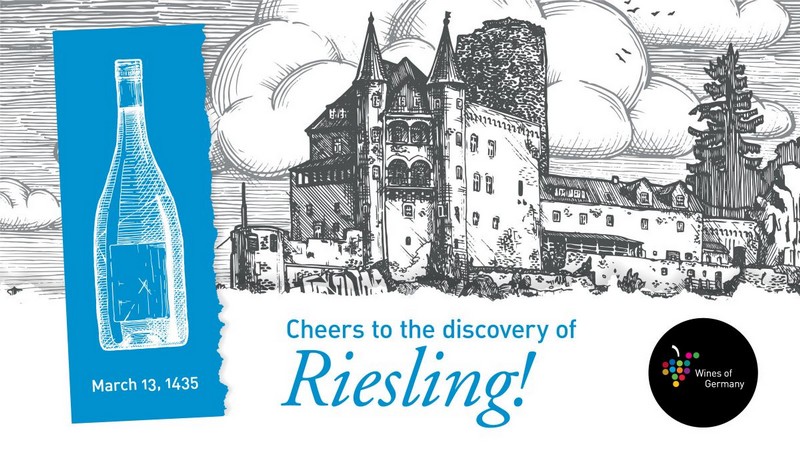
Wines of Germany is marking today, March 13th, as the official birthday of Riesling
in honor of the first documented evidence of the grape, from the cellar
log of Count Katzenelnbogen near the Rheingau region on March 13, 1435.
Since Riesling is known for its food-pairing affinity, expression of terroir, aging potential, electric acidity, and balance of bright fruit flavors, there is certainly a lot to celebrate!
Please join us in celebrating over 500 years of the
versatile and unique varietal with a Riesling toast, and by sharing
photos, tasting notes, and favorite Riesling memories with the hashtag #RieslingBirthday on social media.
Since Riesling is known for its food-pairing affinity, expression of terroir, aging potential, electric acidity, and balance of bright fruit flavors, there is certainly a lot to celebrate!

History of Riesling
- Germany has a deep history of winemaking, dating back before 50 BC, and Riesling has long been considered Germany’s most celebrated grape.
- Winegrowers in the Rheingau and the Mosel have the longest tradition of growing Riesling, with historical records from the early 15th century.
- Evidence of the spread to today's Rheinhessen and Pfalz regions date back to the end of the 15th and the first half of the 16th century.
- As climate and viticulture evolved, the 19th century was seen as a golden age of German wine.
- In 1995, Riesling started again to be seen as the king of German wines, and is associated with a change in the quality-oriented thinking and patterns of consumption in the country.
Riesling Today
Today, with about 23,800 hectares, Germany is home of the world’s largest vineyard area dedicated to Riesling and grows 45% of the world’s Riesling grapes.
The variety is predestined for northerly regions and is planted in all 13 official German wine-growing regions. Depending on type of soil and microclimate, it yields grapes that produce wines with extremely diverse nuances, ranging from bone dry to lusciously sweet.
A “typical” German Riesling is reminiscent of peach or apple on the nose, and has pronounced acidity. It is fantastic for food pairing and sparkling wine production.
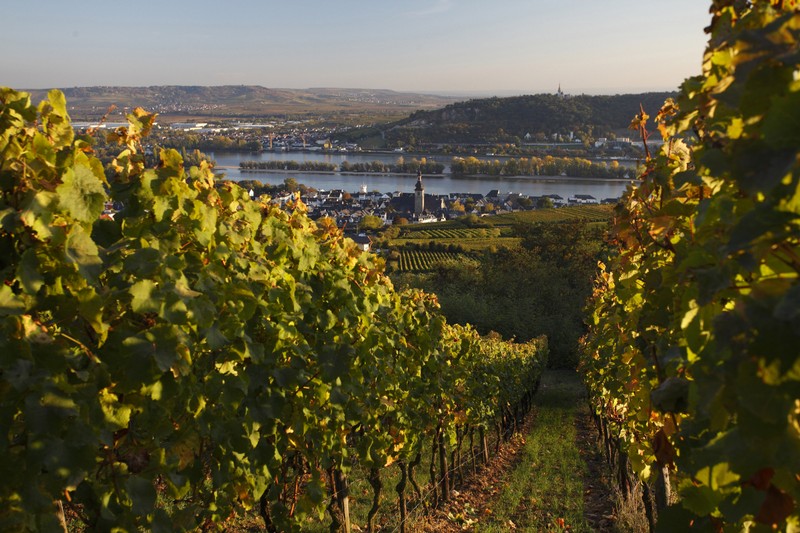
Festivities
for Riesling Birthday will take place on a global scale this year, from
North America to the Netherlands to China and Japan.
Prost to Progress! Celebrate International Women’s Day with German Women Winemakers
Information Supplied by Wines of Germany
-19 March 2018-
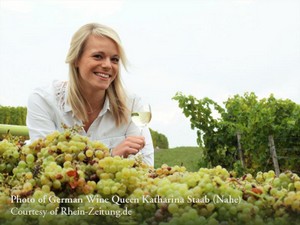 In her 2010 book, Women in Wine: The Rise of Women in the Global Wine Industry, author Ann B. Matasar noted, “No business or industry reaches further back in history or is more global in scope than the wine industry. And no industry has so resolutely excluded women from positions of influence for so long.” Nearly a decade after Women in Wine was published, it’s evident that progress has been made as women are increasingly taking charge in historically male-dominated roles within the industry, from distributors and sommeliers to the vineyards and cellars where the wine is grown and made.
In her 2010 book, Women in Wine: The Rise of Women in the Global Wine Industry, author Ann B. Matasar noted, “No business or industry reaches further back in history or is more global in scope than the wine industry. And no industry has so resolutely excluded women from positions of influence for so long.” Nearly a decade after Women in Wine was published, it’s evident that progress has been made as women are increasingly taking charge in historically male-dominated roles within the industry, from distributors and sommeliers to the vineyards and cellars where the wine is grown and made.Still, the wine industry has a long journey ahead towards inclusion; as reported by Wine Enthusiast in October 2017, women make up just about 20% of the industry’s workforce. Especially in Old World wine countries, there is a history of vineyards and wineries staying in the hands of one family for generations, passed down from father to son. In the last decade, however, this old-fashioned tradition has become a thing of the past, and there are now many female winemakers and trailblazers in Germany continuing to change the wine world for the better. Even the German Wine Institute is female-led by DWI managing director Monika Reule!
The industry as a whole is benefitting from innovative technology, a fresh focus on sustainability, and a growing force of women advancing in ranks from vineyard management to international sales, education, and journalism. To celebrate International Women’s Day, we have highlighted a few notable female winemakers from a range of Germany’s wine regions, including some new names and some from centuries-old estates. Whether these women are establishing their own brands or refreshing legendary labels, they are all paving the way for more women to work in wine at every level. We’ll drink to that!
Growing up among winemakers in Dernau, Julia was destined for the wine industry. After an internship with Meyer-Näkel in the Ahr and a degree in Viticulture and Oenology from the University at Geisenheim, one of the world’s premiere institutions, Julia was named a German Wine Queen in 2012 and embarked on a year representing German wines around the world. Julia then returned to the Ahr to work at her family’s estate and began making a small amount of wine under her own name, focusing specifically on Spätburgunder. Julia plans to increase production of her own wines as she takes over her family’s estate, and is dedicated to focusing on the best sites with the oldest vines, grown using sustainable practices. As a member of Generation Riesling, Julia has been recognized for the innovative practices that she brings to her family’s winemaking tradition.
Photo courtesy of SchatziWines.com
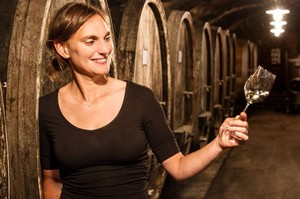 Purchased by the Diel family in 1802, Schlossgut Diel is of great historical significance in the Nahe. The winery, owned by Armin Diel, is now overseen by his daughter Caroline, who brings together innovative practices, like sustainable methods, with historic traditions, like the use of clay tanks. Caroline studied at Geisenheim and took internships with renowned producers from around the world before taking over her family’s estate. While embracing her family’s history of producing exceptional, terroir-driven Riesling, Caroline has taken a fresh approach and implemented a new philosophy towards winemaking. Most notably, Caroline has reduced the amount of residual sugar in the Prädikat wines, bringing her own style to her family’s estate.
Purchased by the Diel family in 1802, Schlossgut Diel is of great historical significance in the Nahe. The winery, owned by Armin Diel, is now overseen by his daughter Caroline, who brings together innovative practices, like sustainable methods, with historic traditions, like the use of clay tanks. Caroline studied at Geisenheim and took internships with renowned producers from around the world before taking over her family’s estate. While embracing her family’s history of producing exceptional, terroir-driven Riesling, Caroline has taken a fresh approach and implemented a new philosophy towards winemaking. Most notably, Caroline has reduced the amount of residual sugar in the Prädikat wines, bringing her own style to her family’s estate.Photo courtesy of Schlossgut Diel on Facebook
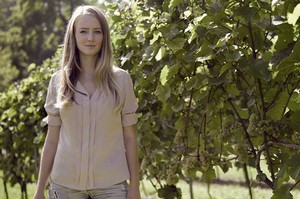 Juliane Eller, JuWel-Weine, Rheinhessen
Juliane Eller, JuWel-Weine, RheinhessenWhile the Eller family winery and vineyard was founded in the 1980’s, the Juwel-Weine brand is a true gem of the new millennium. When Juliane returned from her studies at Geisenheim at age 23, she wasted no time in bringing new life to the family business. With her parents’ blessing and support, she overhauled their technique, focus, and branding, putting her own name on the fresh, modern labels, expanding their offering to include the Pinot varietals and Silvaner as well as Riesling, and moving to hand-picking and organic practices. She is the primary winemaker and cellar master, while her sister, Katharina, oversees the tasting room and marketing. Juliane’s visionary approach is recognized through her membership in Generation Riesling, a network of German winemakers under 35 years old with an international focus and a dedication to modern, high quality, and dynamic wine production.
Photo courtesy of RegalWine.com
 Coming from a family of doctors, it was chance that led Eva to the wine industry. After working at a winery in Cape Town, South Africa for a summer, Eva returned home to Bremen and chose to study wine. Eva quickly got to work with an apprenticeship at Schloss Johannisberg in the Rheingau and studying at Geisenheim. After years of working alongside renowned winemakers through various internships at wineries around the world, including Johannes Leitz in the Rheingau, and attending business school, Eva began to focus on her own winery in 2011. A self-made winemaker and businesswoman, Eva is now fully dedicated to Weingut Eva Fricke. The estate, now 10 hectares, is a small, artisanal winery that is completely dedicated to quality and sustainable processes.
Coming from a family of doctors, it was chance that led Eva to the wine industry. After working at a winery in Cape Town, South Africa for a summer, Eva returned home to Bremen and chose to study wine. Eva quickly got to work with an apprenticeship at Schloss Johannisberg in the Rheingau and studying at Geisenheim. After years of working alongside renowned winemakers through various internships at wineries around the world, including Johannes Leitz in the Rheingau, and attending business school, Eva began to focus on her own winery in 2011. A self-made winemaker and businesswoman, Eva is now fully dedicated to Weingut Eva Fricke. The estate, now 10 hectares, is a small, artisanal winery that is completely dedicated to quality and sustainable processes.Photo courtesy of EvaFricke.com
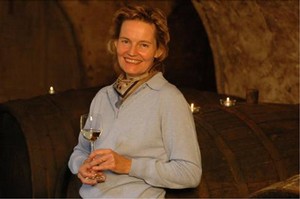 Sofia Thanisch, Weingut Dr. Thanisch, Mosel
Sofia Thanisch, Weingut Dr. Thanisch, MoselNot only is Weingut Dr. Thanisch a 375-year-old, world-renowned estate, but it also has the incredible distinction of being run by four generations of women since 1895! Sofia Thanisch is the current director of the Bernkastel winery and vineyards and part owner of the “Doctor” vineyard, which is famously regarded as one of the best plots in Germany. With a rich tradition in winemaking as well as women’s empowerment, the estate grows 100% Riesling and was a founding member of the VDP in 1910. The Thanisch family is dedicated to producing high quality wines through sustainable viticulture and spontaneous, natural fermentation. Sofia took over the family business from her aunt Mechthild in 1996 and plans to pass it on to her daughters Christina and Juliane, who will become the 5th generation of female leaders at the estate.
Photo courtesy of Thanisch.com
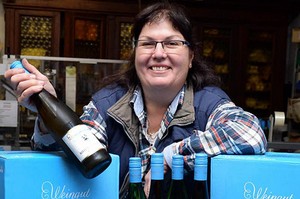 The Weegmüller family began producing wine in 1685, making Weingut Weegmüller the oldest estate in the Pfalz. Continuing the legacy is Stefanie Weegmüller-Scherr, owner, winemaker, and cellar master for more than 25 years. While Stefanie is the 11th generation to run the winery and vineyard, she fully embraces current trends and evolving tastes, focusing on dry, high quality wines, practicing ecological viticulture, and offering a range of grape varietals. Stefanie recently planted Grüner Veltliner for the first time for her family, which proved to be an international success. Stefanie is regarded for her technical expertise and her passion for the industry, but producing wine is not a one-woman job. Her sister, Gabriele Weegmüller, is responsible for marketing, sales, exporting, and customer service, while four more women hold top positions in supporting the small family business.
The Weegmüller family began producing wine in 1685, making Weingut Weegmüller the oldest estate in the Pfalz. Continuing the legacy is Stefanie Weegmüller-Scherr, owner, winemaker, and cellar master for more than 25 years. While Stefanie is the 11th generation to run the winery and vineyard, she fully embraces current trends and evolving tastes, focusing on dry, high quality wines, practicing ecological viticulture, and offering a range of grape varietals. Stefanie recently planted Grüner Veltliner for the first time for her family, which proved to be an international success. Stefanie is regarded for her technical expertise and her passion for the industry, but producing wine is not a one-woman job. Her sister, Gabriele Weegmüller, is responsible for marketing, sales, exporting, and customer service, while four more women hold top positions in supporting the small family business.Photo courtesy of RheinPfalz.de
Julia, Caroline, Eva, Sofia, and the Eller and Weegmüller sisters are not the only women in German winemaking, and progress is being made, but they are still far outnumbered by male winemakers. We look forward to welcoming more and more women into the wine world in the years to come!
2017 German Wine Vintage
Information Supplied by Wines of Germany
-12 March 2018-
The German 2017 grape wine harvest has yielded good to very good wine qualities with in many cases low volumes. Unusually heavy and widespread frosts in April were the key reason behind the relatively large crop losses at many estates. The year´s total intake across the country of 7.5 million hectolitres is expected to be 18 per cent down on the previous year as well as the ten-year average of 9 million hectolitres.
In most German wine regions the harvest was completed very early, with only a very few estates leaving grapes in the vineyard for a possible ice wine production. The qualities harvested are on the whole very satisfactory, resulting in a 2017 vintage of generally light, fruity wines with great finesse which match the current trend in consumers´ tastes.
Ahr (563 ha)
After the spring frosts in April had already reduced yields, followed by heavy rains in the summer, selective harvesting was the order of the day in the Ahr. With the early ripening varieties such as Frühburgunder (Pinot Précoce), the harvest had in some areas already begun in August. The second half of September brought ideal harvest weather, which benefitted the region´s main variety Spätburgunder (Pinot Noir) as well as Riesling, leading to good qualities. With cropping levels anticipated at 31,000 hectolitres – roughly 21 per cent below the long-term average -, the Ahr wines have a welcome high level of extract and body and will delight the wine lovers´ palate with their good structure and typically fine varietal fruit.
Baden (15,812 ha)
“We got off lightly” was how many Baden producers summarized the 2017 vintage. This year´s frost catastrophe in the region was the biggest since 1953. Many vines recovered and produced secondary shoots but these generated only a few grapes. Thus already at the beginning of October, after a quick harvest, yields of 70 hectolitres per hectare were obtained – lower levels were last recorded only in 2010 and 2013. Harvest volume estimates of 1.05 million hectolitres are 15 per cent below the ten-year average and 19 per cent down on the previous year. However, must weights and qualities were certainly good, especially with the later ripening varieties. At the end of October, the sunny weather even gave rise to the occasional noble sweet qualities, from Auslese to Trockenbeerenauslese. Overall Baden´s 2017 wines are refreshingly rich in aromas and complex with a harmonious acid structure.
Franken (6,107 ha)
One should be careful with superlatives but the Franken winegrowers are all agreed: 2017 marked the fastest and earliest harvest in the region´s history. This is of course linked to the capricious weather, which the year was certainly not short of. With a great deal of effort, the damage caused by the spring frosts could be minimized, so that despite some hail damage in the summer and heavy rain, as well as the corresponding pre-harvest grape selection, the harvest volume of around 487,000 hectolitres is expected to be even slightly higher than the previous year. The wines are mostly refreshingly light with vitalizing fruit flavours and are thus a nice contrast to the very concentrated, full-bodied vintage 2015 and a complement to the fruit-driven 2016. The slender, elegant 2017 is a particularly attractive Franken vintage!
Hessische Bergstrasse (461 ha)
A turbulent year lies behind the winegrowers of the Hessische Bergstrasse. Yields were not only depressed by the damaging frosts, which affected producers to varying degrees. Problems also arose due to the partly wet weather, requiring growers to undertake strict grape selection by hand to preserve quality. Fortunately September brought cool nights, albeit at the beginning also a good deal of rain, which further accelerated a harvest that had already begun early. By the 10 October all grapes were in the cellar. All in all, total yields of 25,000 hectolitres fall significantly below the norm of 31,000 hectolitres but the quality is right, in particular with the later ripening varieties such as Riesling. The Bergstrasse can look forward to a 2017 vintage which is varietally typical and fresh but above all graceful and elegant.
Mittelrhein (467 ha)
Winegrowers in the Mittelrhein were mostly spared from major crop losses due to the April frosts, with relatively moderate temperature lows of minus two degrees Celsius recorded on the steep vineyard sites. That said, the year posed other major challenges for growers in the form of a lot of rain in the summer and unsettled, wet weather at harvest time, with only a few exceptions. Rigorous grape selection was required to separate healthy from rotten berries, rewarding those who worked scrupulously with good qualities. The harvest, which had begun in September, was largely over by the beginning of October. Noble sweet grapes up to Trockenbeerenauslese were also harvested. The total yield is approx. 33,000 hectolitres and thus roughly on a par with the previous year´s figure. The wines are proving to be aromatic and balanced to concentrated with a wonderful interplay of sweetness and acidity.
Mosel (8,796 ha)
This year´s harvest in the Mosel was the earliest ever and the smallest in volume terms for half a century. This was of course attributable to the April frosts, which affected almost a third of the region´s vineyards. Even the steep sites suffered, which rarely happens as cold air normally flows down slope. At 600,000 hectolitres, the harvest volume is significantly lower than the long-term average of 800,000 hectolitres. The summer brought warm, dry weather as well as heavy rain and isolated hail storms. Picking got underway in mid-September, topping the earliest harvest on record from 2011 by ten days. Riesling grapes which were harvested later were able to profit from the favourable weather conditions in the second half of September. This resulted not only in good must weights, measuring up to 200 degrees Oechsle in the noble sweet grapes, but also balancing fruit acidity levels. The 2017 Mosel wines will be slender, playful and mineral with a wide quality spectrum up to Trockenbeerenauslese, especially in the Saar and Mittelmosel.
Nahe (4,205 ha)
The frost night of 20 April caused considerable damage to the vines in the Nahe, also partly in the region´s top and steep vineyards. Even seasoned winegrowers could barely remember anything quite like it - yields were 30 to 80 per cent below the usual results. Happy the ones who lit candles in the vulnerable sites and largely managed to save the grapes. To make matters worse, there were hailstorms during the year, so that a minus of 18 per cent compared with the long-term average is anticipated. However, the mostly favourable weather in the summer and at harvest time had a positive influence on the remaining grapes, which yielded pleasing must weights. With extreme dedication, winegrowers nurtured every healthy berry and this effort brings its rewards: The Nahe wines of the vintage 2017 are proving to be true to variety, full-bodied and very well-balanced.
Pfalz (23,590 ha)
In Germany´s second largest wine region, 2017 will also deliver good wine but less of it. Owing to frost damage in April, growers in the Pfalz brought in 1.8 million hectolitres of grapes - approx. 19 per cent less than the average. After a wet July, however, the weather gods were somewhat more benign in August and September. At harvest time, which began early in August, the weather brought warm days and cool nights, which were perfect for a good aroma profile. In September it then turned cooler towards the end of harvest, while the rain was not excessive. The grapes were thus able to accumulate a lot of sugar and registered good acidity levels. The 2017 vintage in the Pfalz promises characterful and expressive wines with a lovely interplay of aromas, especially in the aromatic varieties such as Sauvignon Blanc or Muskateller. The young wines are already proving to be stimulating and appealing.
Rheingau (3,168 ha)
The year 2017 showed again that the climatic challenges for the Rheingau winegrowers are not easing up. Volume estimates of 180,000 hectolitres are approx. 18 per cent down on the previous year. To blame were first and foremost the frosts in April, with the addition of major hail damage in the centre of the region in August. Nature was able to offset much of this with good weather during flowering and harvest. At the beginning of August, vine growth was ten days ahead of the long-term average. Rigorous grape selection became necessary after heavy rains during the ripening phase, which ultimately resulted in very good grape quality and must weights for the late ripening varieties Riesling and Spätburgunder. “Our growers expect a good vintage”, concluded Peter Seyffardt, president of the Rheingau Winegrowers´ Association. Aromatic wines with harmonious acidity and good structure are the defining characteristics of the current vintage.
Rheinhessen (26,628 ha)
Total harvest figures of two million hectolitres in Germany´s largest wine region are significantly lower – approx. 20 per cent less - than the previous year and the long-term average. This was caused by frosts in April and hail storms especially in the Alzey-Worms district later in the season. Also in other respects 2017 had one or two hurdles “up its sleeve” for the Rheinhessen growers. “A roller coaster ride” was how the year´s progression was described and steady nerves were required. The weather gods showed themselves to be more benign during the extremely early harvest following heavy rains shortly beforehand. The mild weather with its cold nights helped many grapes on the home run to a good level of ripeness and plenty of aroma. The young wines in Rheinhessen are proving to be very fruit-driven with a well-balanced, refreshing acidity. Especially the late-ripening varieties such as Riesling benefitted from this challenging vintage 2017.
Saale-Unstrut (765 ha)
Growers in the Saale-Unstrut region can look back on a good year. There were no major weather problems in the sheltered – often terrassed – sites along the rivers and the east of Germany remained largely free of frost damage in April. The mix of sun, rain and warmth in summer was ideal for the grapes and encouraged strong growth in the canopies. After an unusually long ripening period, the harvest got underway at the beginning of September. The dry wines are delicate, fruity and graceful - typically Saale-Unstrut. But the harvest also rendered full-bodied Spätlese (late-harvest) grapes up to mid-October, when picking was completed. At an estimated 58,000 hectolitres, volumes are even slightly higher than the previous year´s figure of 54,000 hectolitres, an increase of roughly 7 per cent.
Sachsen (11,306 ha)
In Germany´s easternmost wine region, major frost damage also remained at bay. Both quantity and quality were spot-on. In the often warm weather, the grapes had a long period in which to ripen. The harvest stretched into the second half of October, enabling for example the Riesling berries to attain must weights into the high 90 degrees Oechsle. Fruity, juicy wines with good levels of extract are the pleasing result. The harvest volume of roughly 27,000 hectolitres is forecast to fall slightly below the previous year´s figure but significantly higher than the long-term average of 21,000 hectolitres. 2017 was a good wine year in Sachsen with a long harvest season, which rewarded the efforts of the growers. Besides assiduous work in the vineyard and careful selection, the great virtue was patience, which gave the grapes the necessary time for ripening.
Württemberg (11,306 ha)
In Württemberg a mixed picture is emerging at the end of the wine year 2017. The year had brought a lot of hardship, the severe April frosts causing partly considerable crop losses. In some instances, a minus of 25 to 30 per cent - in regions such as the Taubertal or Hohenlohe even 50 to 60 per cent - had to be absorbed. Volume estimates across the region of 850,000 litres are 20 per cent below the long-term average and 26 per cent down on the previous year. Unfavourable weather at harvest time required in many places an early and rapid picking, which was largely over within the short – and rare – time span of only three weeks. This was also due to the fact that the late ripening varieties had to be picked directly after the early ones. Württemberg growers are satisfied with the qualities harvested - especially the late ripening varieties yielded healthy grapes with high must weights. One can therefore expect a vintage of balanced, fruity wines with true-to-varietal aromas.
AustrianWineEstates
Tidbits of Information Archive
AustrianWineEstates is a website devoted to a selection of fine wine estates from Austria, whose wines are available in the United States through wine importer and distributor, Slocum & Sons, located in North Haven, Connecticut. This portfolio has been created by Eric Litchfield, a wine professional and German and Austrian wine expert with 28 years of experience importing and promoting the wines of Germany and Austria. He has spent considerable time selecting producers that define today's highest standards of wine making. Mr. Litchfield's philosophy is to allow the wine producer and nature to harmonize equally, utilizing sustainable agriculture, organic and biodynamic farming to reach the purest expression of grape varietal, microclimate and terroir, yielding wines of supreme balance and elegance.
____________________________________________________________

